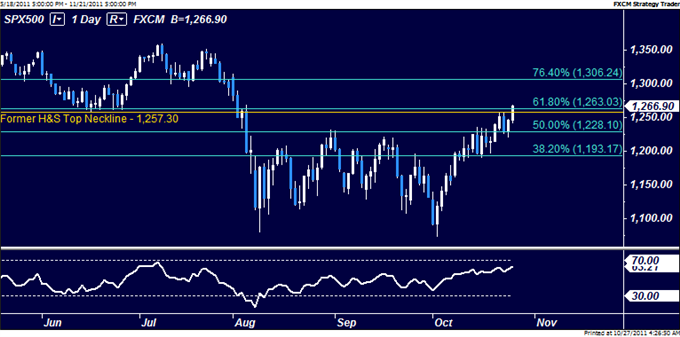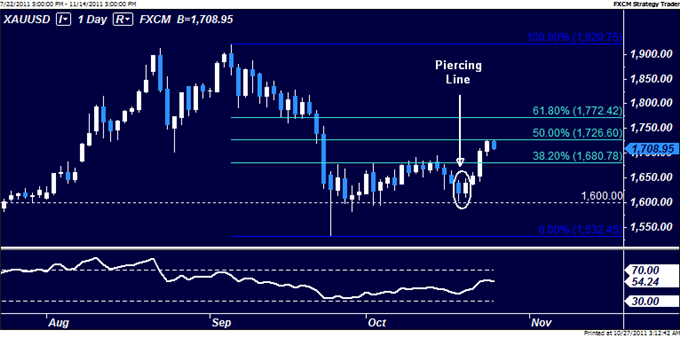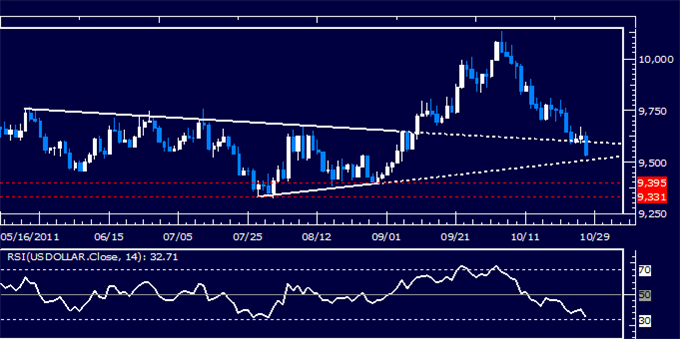hi guys
new update entry before sleeping...test bullet....nite all
Thursday, October 27, 2011
S&P 500 on the Verge of Major Breakout, US Dollar at Two-Month Low
THE TAKEAWAY – The safe-haven US Dollar has dropped to a two-month low while the S&P 500 is on the verge of completing a significant breakout to the upside.
S&P 500 – Prices are probing above support-turned-resistance at 1257.30, the former neckline of a major Head and Shoulders top chart formation carved out between January and August, a boundary reinforced by the 61.8% Fibonacci retracement level at 1263.03. A daily close above the latter boundary exposes the 1300 figure, followed by the 76.4% retracement at 1306.24. Near-term support lines up at 1228.10, the 50% Fib.

CRUDE OIL – The broad outlines of positioning are little changed from what we noted yesterday. Prices put in a Shooting Star candlestick below resistance at $94.87, the 50% Fibonacci retracement of the drop from May’s swing high, pointing to a loss of bullish momentum and hinting a move lower is ahead. Initial support lines up at $90.17, the 38.2% Fib, with a break below that targeting the 23.6% and 38.2% extension levels at $85.33 and $79.62.

GOLD – Prices are recoiling from resistance at $1726.60, the 50% Fibonacci retracement, with sellers aiming at support marked by the 38.2% level at $1680.78. Alternatively, a reversal through immediate resistance exposes the 61.8% Fib at $1772.42.

US DOLLAR – Prices are pushing through resistance-turned-support at a falling trend line connecting major highs since late May. Near-term support stands at a rising boundary set from the late July bottom, now at 9507, with a break below that exposing the 9331-9395 region.

8hour Chart - Created Using FXCM Marketscope 2.0
Wednesday, October 26, 2011
Euro rallies on broad Greek write-downs agreement
In a frenetic last minutes of trading, finally, a currency seems to be moving in the Forex market; and this could be no other than the Europen shared currency, which is being bid to the boots after headlines suggest Eurozone official have reached a 'broad agreement' on plan for banks to voluntarily cut Greece's debt. Private creditors are thought to accept a 50% haircut on Greek bonds.
At present, the Euro has recovered from an early dip at 1.3865 to rise as high as 1.3952 as a fair amount of short-covering action is noted, meaning all those investors hoping to make lucrative bets against the Euro will have to sit on its hands again, waiting a better day to pick the right timing to play the Euro short trade; only difference is that they will be now a bit shorter of capital. The rollercoaster in the pair continues, with a short-lived pullback to retest the former intra-day high at 1.3918 before another vigorous take off. Euro approaching highs as we type-up the report.
As rightly noted by renowned market expert Jamie Coleman, from Forexlive, eralier on the week: "The most frustrating thing about financial markets is that you can have the exact right macro view but still lose money if your entry points are not perfect. I fear a sharp short-covering rally in the next 24-hours followed by renewed weakness later in the week after the event risk from the EU summit is over."
At present, the Euro has recovered from an early dip at 1.3865 to rise as high as 1.3952 as a fair amount of short-covering action is noted, meaning all those investors hoping to make lucrative bets against the Euro will have to sit on its hands again, waiting a better day to pick the right timing to play the Euro short trade; only difference is that they will be now a bit shorter of capital. The rollercoaster in the pair continues, with a short-lived pullback to retest the former intra-day high at 1.3918 before another vigorous take off. Euro approaching highs as we type-up the report.
As rightly noted by renowned market expert Jamie Coleman, from Forexlive, eralier on the week: "The most frustrating thing about financial markets is that you can have the exact right macro view but still lose money if your entry points are not perfect. I fear a sharp short-covering rally in the next 24-hours followed by renewed weakness later in the week after the event risk from the EU summit is over."
Monday, October 24, 2011
The 5 Keys to EU Summit #1 – Options for EFSF, Greek Haircuts, Bank Recapitalization and More…
As we head into another busy week of headline driven trading, these will be the 5 main topics of conversation, news coverage, and debate to come out of Sunday’s EU Summit which will drive the narrative for this week.
The 5 keys from the Summit, in order of importance are:
1. Two Main Options for EFSF Use in Bond Markets
The EFSF – with its 440 billion war chest – will try and restore confidence in bond markets by one of 2 options. The image to the right shows that the 440 billion in the EFSF is not enough on its own to cover the needs of bailing out both Spain and Italy, therefore some way is needed to stretch its resources.
One is to guarantee government bond sales, something we have been hearing about all of last week.
The EFSF would ensure the first 20%-30% of losses on bonds from periphery countries. That could mean the EFSF can leverage around 5 times every euro it puts in.
While a guarantee of initial losses should help entice capital to buy bonds, there are inherent problems here as well, including how does a country like Italy self-insure itself through the EFSF and concerns that there will be a two-tiered European bond market.
The second option is to set-up a self-insured EFSF fund – a special purpose vehicle – that would attract outside investment in troubles bonds. The main question here would be what size such a SPV would be and who its intended investors are? One answer may be the IMF, which may be looking to play a bigger role in trying to alleviate the pressure of the Euro-zone sovereign debt crisis from global financial markets. A SPV boosted the the reserve of the IMF may be one way to help put more money into the bailout coffers.
You could also see both options being used in parallel. Again, we have to wait till Summit #2 on Wednesday for further clarification. Expect headlines around the EFSF role in propping up periphery secondary bond markets to drive market action.
2. No Forces Restructuring of Greek Debt, Voluntary Bank Involvement
 Key in going forward for the resolution of the Euro-zone sovereign debt crisis is making sure the Greek debt load is sustainable. That means a significant write-down for bondholders of Greek debt. In the July 21st Summit Greek bondholders – banks and other large financial institutions – agreed to a voluntary 21% write-down. The demand from politicians now – especially in Germany – is a 50% haircut, but the bondholders participation will not be coerced, but will still remain voluntary.
Key in going forward for the resolution of the Euro-zone sovereign debt crisis is making sure the Greek debt load is sustainable. That means a significant write-down for bondholders of Greek debt. In the July 21st Summit Greek bondholders – banks and other large financial institutions – agreed to a voluntary 21% write-down. The demand from politicians now – especially in Germany – is a 50% haircut, but the bondholders participation will not be coerced, but will still remain voluntary.The latest from Bloomberg, says banks and other bondholders have agreed to 40%. A bigger write-down would change the situation in Greece from one of insolvency to one of liquidity and can help bring more reassurance to markets. Where politicians and banks come together on the issue of haircuts remains an uncertainty, and leaves question marks as we go forward to Summit #2 and maybe even beyond. Watch this to drive headlines in the first half of the week.
3. Bank Capital Needs at 100 Billion Euros, EFSF as Last Resort
The size of the bank recapitalization plan was put at 100 billion euros, and the EFSF will be used only as a last resort after banks own efforts and national efforts fail to raise the funds.
Bloomberg: Bank capital needs — estimated at 100 billion euros ($139 billion) by a person familiar with the deliberations — will be met first by banks themselves, then by national governments, the European agreed. Only when national efforts fail can governments tap the main 440 billion-euro European Financial Stability Facility for cash tochannel to banks.
This too sounds like it will take some while to get fully sorted out, which would be OK if a market panic did not strike in the interim. For the most part an disorderly default from Greece seems less likely now than earlier in September, but still how these capital raising efforts go will be important for confidence in the markets around the health of the European banking sector.
4. No ECB Quantitative Easing
 Germany managed to make sure that the EFSF would not be given a banking license and be able to borrow directly from the ECB. That would have opened up the door for the EFSF to gain additional funding, an approach France sought but was anathema to Germany and the central bank’s outgoing President Jean-Claude Trichet.
Germany managed to make sure that the EFSF would not be given a banking license and be able to borrow directly from the ECB. That would have opened up the door for the EFSF to gain additional funding, an approach France sought but was anathema to Germany and the central bank’s outgoing President Jean-Claude Trichet.It essence that would open the door to the ECB using quantitative easing. Printing money in order to buy bonds, which is going to be one of the main responsibilities of the EFSF now that it’s July 21st changes have been ratified by all 17 euro-zone parliaments. While the Fed, and the Bank of England, and the Bank of Japan get to use quantitative easing, the ECB and Europe will not take up this monetary tool.
5. Screws Tighten on Italy’s Berlusconi
From Financial Times: “Germany and France have turned on Italy to demand further action to boost growth and reduce its huge debt. Angela Merkel, the German chancellor, and Nicolas Sarkozy, French president, held tough talks with Silvio Berlusconi, at the start of the day-long summit in Brussels, insisting that he take more radical measures to restore the trust of investors. Confidence in Italy’s public finances is critical to preventing the spread of the Greek debt crisis across the eurozone, but France and Germany are worried that Mr Berlusconi is not taking tough enough measures.”
We have seen Italy backsliding on austerity measures, first agreed to to get the ECB to buy its bonds during a period of speculative attack. Burlesconi’s popularity in Italy is faltering and politically he barely survived a vote of confidence in Parliament. While measures to spur growth would be celebrated by the people, the recent formula to control debt has been bouts of austerity, which usually work to stunt growth.
We’ll see if there is any movement on the part of Italy and in the meantime we have to monitor Italy’s bond yields for any extended rally.
Sunday, October 23, 2011
Decisive week for the Eurozone ahead
The next several days will be a busy time for EU officials who plan to hold five meetings before Wednesday, October 26 in order to discuss the ways of dealing with the sovereign debt crisis in the Eurozone. But finding a definite solution to the euro area problems will be a strenuous task as the two largest EU economies, France and Germany, remain divided on such crucial issues as the strengthening of the EFSF.
Divergence also exists between the French and the European Commission's ideas of the EFSF operating principles. Earlier this week President Nicolas Sarkozy suggested that the EFSF should be turned into a bank which would have access to ECB's refinancing operations. EU Commissioner for Economic and Financial Affairs Olli Rehn said today that it could be problematic from the legal point of view. He admitted however that the fund needs strengthening.
This morning Angela Merkel spoke before her parliamentary group on the Greek haircut which she admitted will have to be larger than initially thought. She considers insufficient the 21% write-down on Greek debt which was agreed on in July and market rumors are that it will be raised to around 50%.
Paul Donovan from UBS considers the situation in the Eurozone grave, but he is skeptical about the EU leaders' ability to come up with a definite solution for it during the upcoming meetings: “There is little point speculating on the details of the next three summits. Euro 1 seems certain to disappoint. The Euro 2 outcome may or may not disappoint. The G20 will do nothing of note (that is what the G20 always does).” Donovan believes that in fact the troubles in which the EU is at present submerged are of the politicians' own making: “What is happening now is a visible manifestation of the complete failure of the Euro to work as a monetary union. The fault for this lies with politicians, not markets.”
European markets went through moderate advances on Friday's early trading on growing hopes on this weekend's Eurozone leader's meetings to reach an agreement towards a comprehensive plan to tackle the debt crisis which is threatening the region's banking sector. The Eurostoxx 50 Index rose 1.0%, while the German DAX Index added 0.6% and the French CAC index advanced 0.9%. In the UK, the FTSE Index traded 0.4% higher one hour after the opening bell.
Divergence also exists between the French and the European Commission's ideas of the EFSF operating principles. Earlier this week President Nicolas Sarkozy suggested that the EFSF should be turned into a bank which would have access to ECB's refinancing operations. EU Commissioner for Economic and Financial Affairs Olli Rehn said today that it could be problematic from the legal point of view. He admitted however that the fund needs strengthening.
This morning Angela Merkel spoke before her parliamentary group on the Greek haircut which she admitted will have to be larger than initially thought. She considers insufficient the 21% write-down on Greek debt which was agreed on in July and market rumors are that it will be raised to around 50%.
Paul Donovan from UBS considers the situation in the Eurozone grave, but he is skeptical about the EU leaders' ability to come up with a definite solution for it during the upcoming meetings: “There is little point speculating on the details of the next three summits. Euro 1 seems certain to disappoint. The Euro 2 outcome may or may not disappoint. The G20 will do nothing of note (that is what the G20 always does).” Donovan believes that in fact the troubles in which the EU is at present submerged are of the politicians' own making: “What is happening now is a visible manifestation of the complete failure of the Euro to work as a monetary union. The fault for this lies with politicians, not markets.”
European markets went through moderate advances on Friday's early trading on growing hopes on this weekend's Eurozone leader's meetings to reach an agreement towards a comprehensive plan to tackle the debt crisis which is threatening the region's banking sector. The Eurostoxx 50 Index rose 1.0%, while the German DAX Index added 0.6% and the French CAC index advanced 0.9%. In the UK, the FTSE Index traded 0.4% higher one hour after the opening bell.
Thursday, October 13, 2011
Major Retracement EU
hi guys...new update chart see eu tringger..break TL eu must be in major retracement...eu next extension 1.34xx to completed subwave c...TAYOR...
Tuesday, October 4, 2011
EUR/USD climbs above 1.3300
Despite lingering concerns about a Greek default and its consequences, the Euro has accomplished gains versus the Greenback on Tuesday, recovering from a 9-month low of 1.3145 struck during the European session.
EUR/USD rebounded at lows and after a consolidation period around 1.3200, it gathered momentum and climbed more than 100 pips within the last hours to set a fresh day's peak of 1.3315 in recent trade.
At time of writing, the pair is quoting at the 1.3310 zone, where it records a 1.03% gain since opening. "In terms of technical levels, supports are seen at 1.3246, 1.3145 and then at 1.3088", said theTalking-Forex.com team. "On the other hand, resistance levels are seen at 1.3382, 1.3460 which is the 10DMA line and then at 1.3601".
EUR/USD rebounded at lows and after a consolidation period around 1.3200, it gathered momentum and climbed more than 100 pips within the last hours to set a fresh day's peak of 1.3315 in recent trade.
At time of writing, the pair is quoting at the 1.3310 zone, where it records a 1.03% gain since opening. "In terms of technical levels, supports are seen at 1.3246, 1.3145 and then at 1.3088", said theTalking-Forex.com team. "On the other hand, resistance levels are seen at 1.3382, 1.3460 which is the 10DMA line and then at 1.3601".
Subscribe to:
Posts (Atom)



